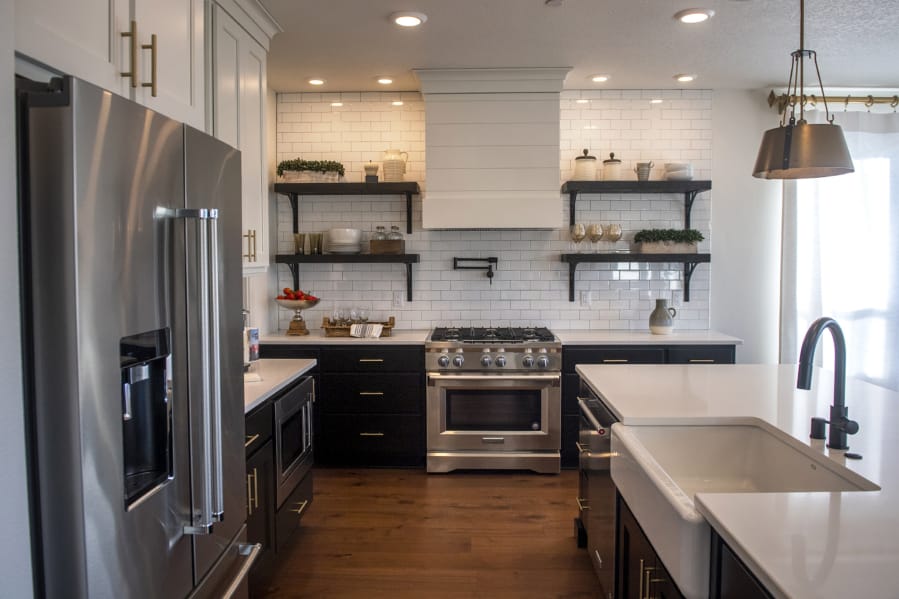Clark County is in the midst of a housing boom, fueled by rapid and sustained population growth throughout the region. Home sales are brisk, new listings are barely keeping pace and the region’s homebuilders are busier than ever.
The rapid influx of new homes offers an opportunity to get a sense of how home design features and styles are evolving and changing in Clark County, particularly as builders adjust to the demands of a growing population and a rising proportion of millennials jumping into the housing market.
To learn more about the latest trends, The Columbian reached out to two of the big names in the Vancouver-area homebuilding industry: Ginn Development and New Tradition Homes.
We opened with a single question: “What’s hot; what’s not?” Ginn marketing manager Chelsea Gaya and New Traditions design studio manager Jerai Laird both had quite a few answers, which we’ve compiled into a list below.
Some trends aren’t universal, Laird noted — every homebuilder has a variety of designs and architectural styles to choose from, and each style has its own unique trends. But some of the most prominent trends are broad enough that they tend to show up across multiple styles — and multiple price points.
What’s Hot: Vinyl flooring
What’s Not: Carpets
There’s a spike in buyers who try to avoid carpeting altogether, Laird said, and even among those who keep it in spots, there’s a trend toward trying to maximize the amount of wood-look flooring and keep the carpet to a minimum.
“Carpet is spendy, expensive to keep up, does not last very long, and is mostly unsanitary,” Gaya wrote in an email.
It doesn’t necessarily have to be true hardwood, Laird added — engineered vinyl planks have taken off in recent years, both because they’re more economical and because they’re naturally waterproof, which is a big selling point for Pacific Northwest homeowners with children or dogs.
Vinyl tends to last longer and require less maintenance than carpet or even true wood floors, Gaya added.
What’s Hot: Dark cabinets
What’s Not: All-white kitchens
All-white kitchens have been a longtime staple for new homebuyers, Laird said, but in recent years the tide has begun to turn in favor of darker cabinet finishes and black stainless steel appliances. Gaya offered a similar assessment: all-white and monochrome are falling out of style.
There’s still demand for all-white color schemes, Laird said, but darker cabinet colors like charcoal and blue are growing in popularity. Some buyers can’t completely let go of the white, she said, so there’s also been a spike in three-tone cabinets.
White kitchens offer a timeless and clean look, Gaya said, but homebuyers are looking for ways to incorporate colors and textures that provide a greater sense of expression.
What’s Hot: Quartz
What’s Not: Granite
Quartz countertops aren’t exactly a recent trend, but their popularity shows no signs of slowing down. There’s a perception that granite has become overdone, Gaya said, and quartz is the easier material to acquire, due in part to tariffs.
Quartz composite materials also offer a wider range of colors and patterns, she said, while requiring less maintenance over time.
“Granite and stainless steel are on their way out and production homebuilders are seeking an equally clean (and) low-maintenance look at the same price point, but with a varied look for interest and innovation,” she wrote.
In terms of more recent countertop trends, Laird points to “waterfall” style kitchen islands, where the counter and legs are all covered with the same material.
What’s Hot: Outdoor elements
Homebuyers are showing a growing desire to bring natural elements and outdoor textures inside, Laird said, often by including more natural wood elements such as authentic wood cabinets, cedar beams and interior barn doors — thick wooden slabs that hang in front of the door frame.
“(Barn doors) have always been around, but we’re seeing it every month now,” Laird said.
There’s also been a resurgence in interior brickwork, she said, such as brick fireplaces.
What’s Not: Subway tiles
Subway tiling — meaning a simple interlocking rectangular pattern for walls, usually in white or gray — is being partially displaced by more round or octagonal styles, according to Gaya. There’s also a trend toward more colorful tiling, again in keeping with an overall move toward more colorful interiors.
“While subway tile is clean and timeless, it’s becoming overdone,” Gaya wrote in an email.
Laird said she’s also seen a shift toward more colorful or patterned tiles, particularly on bathroom and shower walls.
What’s Hot: Bigger showers and bathtubs
Larger shower stalls are in high demand right now, Laird said, and in some cases buyers are opting to ditch the bathtub altogether in order to free up the square footage.
“I’d say half of our homeowners are doing that now,” she said.
For buyers who opt to keep a tub, there’s a similar focus on size and scale. Standalone tubs are taking off, she said, with customers opting for designs that serve more of a decorative function.
The price point may vary on this one, however — Gaya said shower and tub combos are still Ginn’s most popular package, although she said custom homes might be a different story.
What’s Not: Microwave ovens
Laird said this trend has been most visible among younger homebuyers, typically around the age of 30. Rather than having a microwave oven installed above the stove, buyers have been opting for larger and more functional range hoods.
The microwave oven tends to be relocated somewhere lower down and less prominent, Laird said — and a growing number of young homebuyers are opting to ditch them altogether.
What’s Hot: Millennial tastes
More millennials are entering the residential housing market, and the microwave’s fall from grace isn’t the only side effect. Gaya said Ginn has seen an uptick in features like patterned wallpaper and richer paint tones, mostly driven by millennial buyers. Gaya speculated that the shift might be prompted by millennials who are transitioning from renting to homeownership.
“These are all signifying the millennial market becoming more comfortable in making a space their own and customizing it with strong tones and choices without the anticipation of needing to move any time soon,” she wrote.
At the same time, Laird said, budgets aren’t unlimited. She said she’s often seen millennials opting for smaller lots or more compact floor plans in order to splurge on decorative features — or save money for other priorities like vacations.
“Houses have gotten smaller and they’ve gotten prettier,” she said.
Gaya identified millennial culture as one of the driving forces behind another ongoing trend: Open floor plans that combine the kitchen, dining and living room areas. The millennial generation tends to entertain guests at home more often and takes more of a “house party” approach where the preparation of food becomes part of the experience.
“Keeping the kitchen area open to the living room and areas where people congregate is really solidifying in American culture right now,” she wrote.




